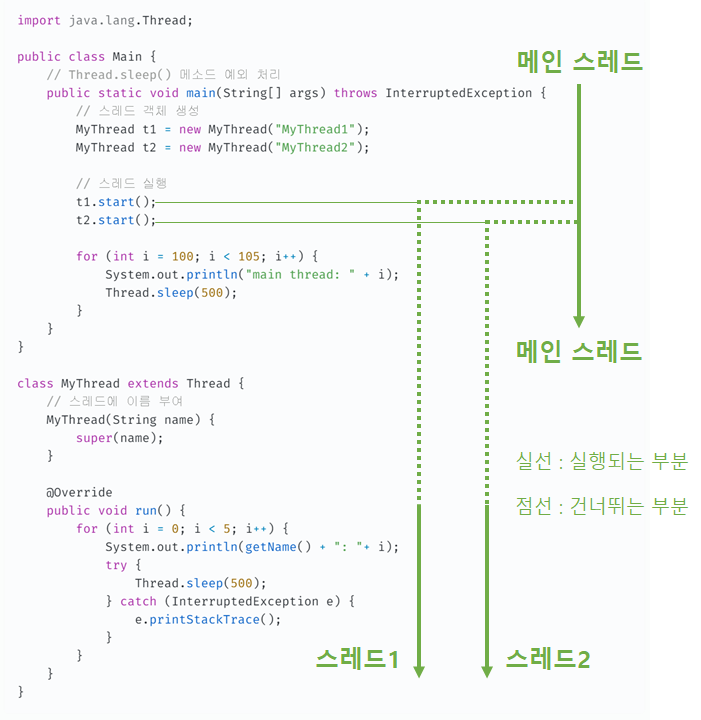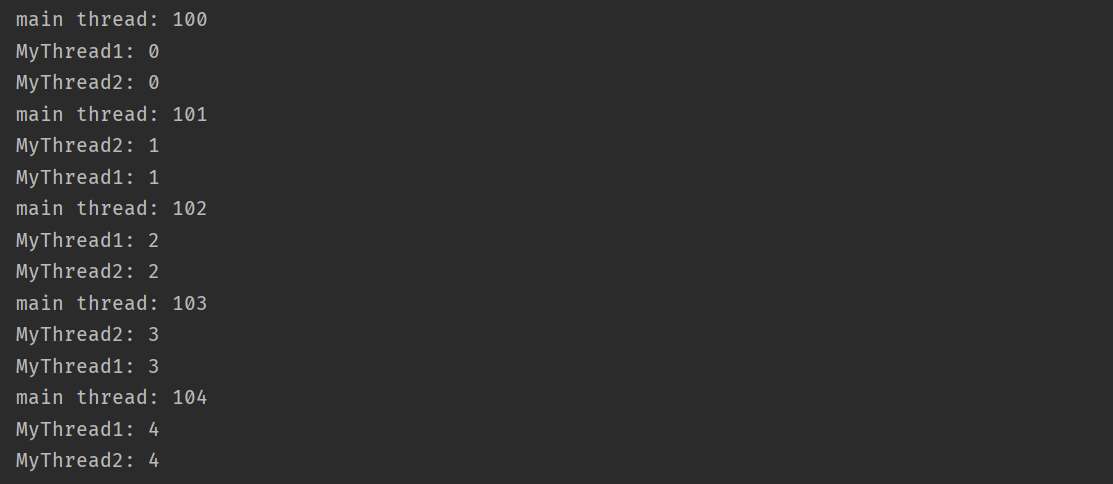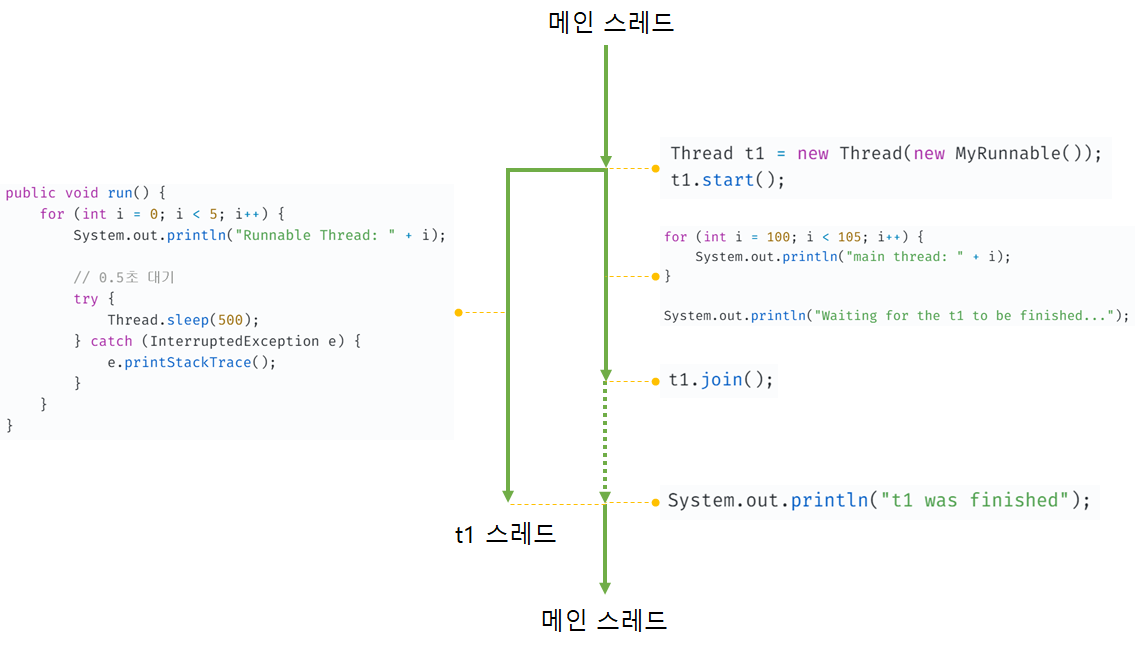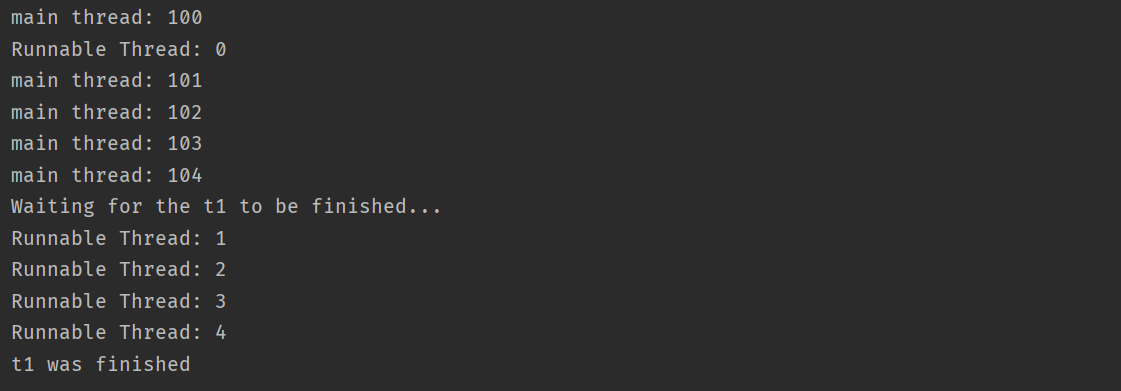자바 스레드 프로그래밍
자바엔 스레드 라이브러리가 내장되어 있다. 왜냐하면 자바 프로그램이 실행되면 JVM이 public static void main(String[] args) 메소드를 실행하는 스레드를 생성하기 때문이다.
Thread 클래스
import java.lang.Thread;
public class Main {
// Thread.sleep() 메소드 예외 처리
public static void main(String[] args) throws InterruptedException {
// 스레드 객체 생성
MyThread t1 = new MyThread("MyThread1");
MyThread t2 = new MyThread("MyThread2");
// 스레드 실행
t1.start();
t2.start();
for (int i = 100; i < 105; i++) {
System.out.println("main thread: " + i);
Thread.sleep(500);
}
}
}
class MyThread extends Thread {
// 스레드에 이름 부여
MyThread(String name) {
super(name);
}
@Override
public void run() {
for (int i = 0; i < 5; i++) {
System.out.println(getName() + ": "+ i);
try {
Thread.sleep(500);
} catch (InterruptedException e) {
e.printStackTrace();
}
}
}
}

-
Thread클래스를 상속받은MyThread클래스에run()메소드를 구현한다. -
MyThread클래스의 객체를 생성하고 그 객체의start()메소드를 호출한다. -
start()메소드 뒤의 코드와run()메소드 코드가 동시에 실행되고, 실행 결과는 위와 비슷할 것이다. 중요한 점은 총 3개의 for문이 동시에 실행되고 있다는 점이다(main()의 for문과run()의 for문 2개).
Runnable 인터페이스
import java.lang.Runnable;
import java.lang.Thread;
public class Main {
public static void main(String[] args) {
// 스레드 객체 생성
Thread t1 = new Thread(new MyRunnable());
Thread t2 = new Thread(new MyRunnable());
// 스레드 실행
t1.start();
t2.start();
for (int i = 100; i < 105; i++) {
System.out.println("main thread: " + i);
// 0.5초 대기
try {
Thread.sleep(500);
} catch (InterruptedException e) {
e.printStackTrace();
}
}
}
}
class MyRunnable implements Runnable {
@Override
public void run() {
for (int i = 0; i < 5; i++) {
System.out.println("Runnable Thread: " + i);
// 0.5초 대기
try {
Thread.sleep(500);
} catch (InterruptedException e) {
e.printStackTrace();
}
}
}
}
-
Runnable인터페이스의run()메소드를 구현한MyRunnable클래스를 만든다. -
MyRunnable클래스의 객체를 생성하고Thread클래스의 생성 인자로 넘겨준다. -
Thread클래스 객체의start()메소드를 실행한다. -
start()메소드 뒤의 코드와,MyRunnable클래스의run()메소드 코드가 실행된다.
Thread.join()
public class Main {
public static void main(String[] args) {
// 스레드 객체 생성 및 실행
Thread t1 = new Thread(new MyRunnable());
t1.start();
for (int i = 100; i < 105; i++) {
System.out.println("main thread: " + i);
}
System.out.println("Waiting for the t1 to be finished...");
try {
t1.join();
} catch (InterruptedException e) {
e.printStackTrace();
}
System.out.println("t1 was finished");
}
}

위 그림과 같이 t1.join() 메소드는 t1 스레드의 실행이 끝날 때까지 현재 스레드(메인 스레드)의 실행을 일시정지하는 메소드다. 주로 데이터 동기화나 스레드의 실행 순서를 조정할 때 사용한다.
MyRunnable 클래스는 이전에 작성한 클래스를 그대로 사용했다.
Thread.sleep()
해당 스레드를 특정 시간만큼 일시정지한다.
synchronized
이 키워드가 붙은 메소드엔 1개의 스레드만 접근할 수 있다. 주로 공유자원에 접근하는 메소드에 이 키워드를 붙여 메소드 전체를 critical section으로 만든다.
wait() notify()
멀티스레딩 예제
적분
소수 개수 세기
행렬 계산
생산자 소비자 모델

생산자 스레드
작업 큐에 작업을 넣는 스레드로서 작업 큐가 가득 차 있으면 자신은 자고, 자고 있는 소비자를 모두 깨우는 역할을 한다.
소비자 스레드
작업 큐의 작업을 소비하는 스레드로서 작업 큐가 비어 있으면 자신은 자고, 자고 있는 생산자를 모두 깨우는 역할을 한다.
